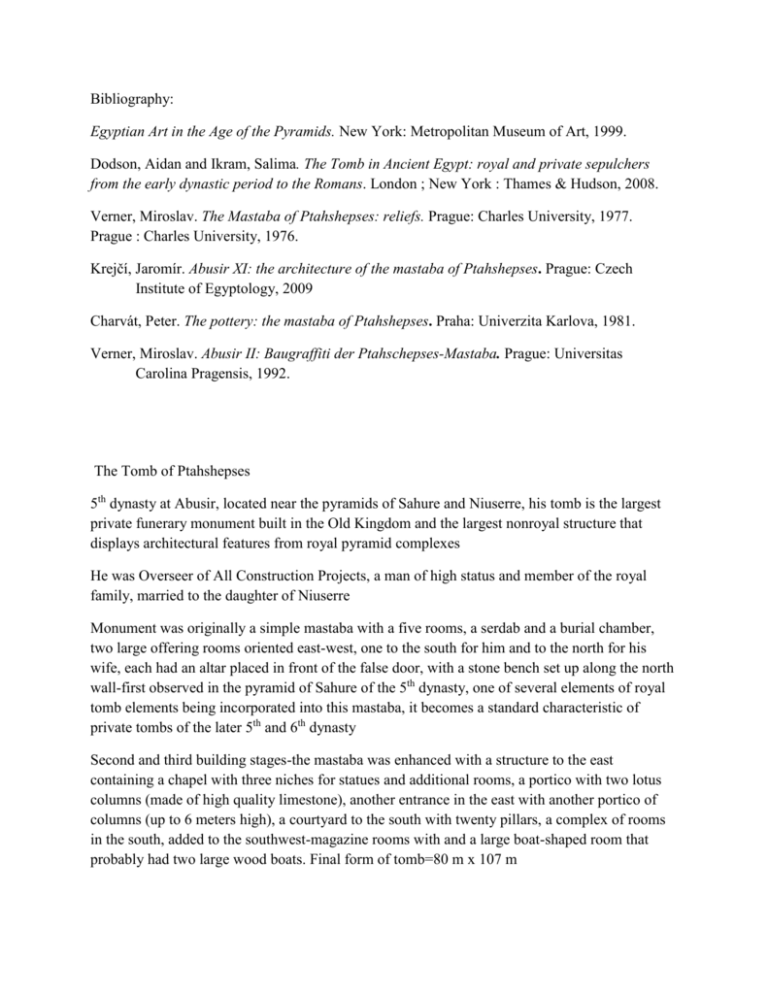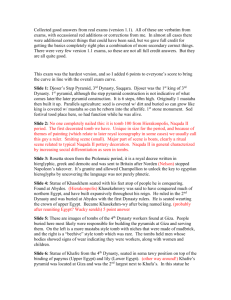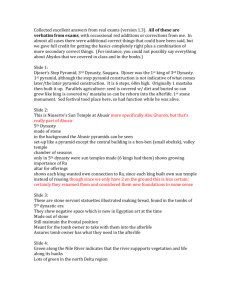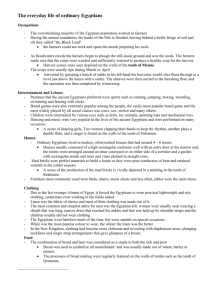Tomb of Ptahshepses
advertisement

Bibliography: Egyptian Art in the Age of the Pyramids. New York: Metropolitan Museum of Art, 1999. Dodson, Aidan and Ikram, Salima. The Tomb in Ancient Egypt: royal and private sepulchers from the early dynastic period to the Romans. London ; New York : Thames & Hudson, 2008. Verner, Miroslav. The Mastaba of Ptahshepses: reliefs. Prague: Charles University, 1977. Prague : Charles University, 1976. Krejčí, Jaromír. Abusir XI: the architecture of the mastaba of Ptahshepses. Prague: Czech Institute of Egyptology, 2009 Charvát, Peter. The pottery: the mastaba of Ptahshepses. Praha: Univerzita Karlova, 1981. Verner, Miroslav. Abusir II: Baugraffiti der Ptahschepses-Mastaba. Prague: Universitas Carolina Pragensis, 1992. The Tomb of Ptahshepses 5th dynasty at Abusir, located near the pyramids of Sahure and Niuserre, his tomb is the largest private funerary monument built in the Old Kingdom and the largest nonroyal structure that displays architectural features from royal pyramid complexes He was Overseer of All Construction Projects, a man of high status and member of the royal family, married to the daughter of Niuserre Monument was originally a simple mastaba with a five rooms, a serdab and a burial chamber, two large offering rooms oriented east-west, one to the south for him and to the north for his wife, each had an altar placed in front of the false door, with a stone bench set up along the north wall-first observed in the pyramid of Sahure of the 5th dynasty, one of several elements of royal tomb elements being incorporated into this mastaba, it becomes a standard characteristic of private tombs of the later 5th and 6th dynasty Second and third building stages-the mastaba was enhanced with a structure to the east containing a chapel with three niches for statues and additional rooms, a portico with two lotus columns (made of high quality limestone), another entrance in the east with another portico of columns (up to 6 meters high), a courtyard to the south with twenty pillars, a complex of rooms in the south, added to the southwest-magazine rooms with and a large boat-shaped room that probably had two large wood boats. Final form of tomb=80 m x 107 m Reliefs- colored reliefs depicting a variety of scenes, including Ptahshepses’ sons, workmen creating a statue of Ptahshepses for the tomb, and standing Ptahshepses in a knotted kilt holding a staff and wearing a wig on the outside columns, butchering of meat is depicted on the western wall along with offering bearers and piles of food offerings, north and south wall reliefs depict offering bearers approaching the seated Ptahshepses ready to receive their goods This tomb reflects a deviation from the simple mastabas of private individuals in the 4th dynasty, as this mastaba in many ways seeks to imitate royal buildings (ex.: room to the south with a staircase leading up to the roof, modeling royal valley and pyramid temples, possibly this staircase was for dragging the coffin up to the roof and then lowering it into the burial shaft, but the purpose is still widely debated as the entrance shaft in the substructure was situated in a special room in the superstructure of this tomb and others with staircases The roof of the sarcophagus chamber-consisted of four pairs of huge limestone blocks (like those used in royal pyramids of the 5th and 6th dynasty)-clearly he was well-versed in construction of royal pyramids as his title also suggests The columns are also unique as normally kings had lotus-form columns made out of wood if they had them at all (more common are papyriform columns of granite), while Ptahshepses uses limestone to construct his lotus-columned porticoes The pillared courtyard-another example of an imitation of royal architecture, at Abusir the kings of the 5th dynasty had pyramid courts with columns, pillared courts are also common in pyramid temples of queens of the 5th and 6th dynasty, the walls of the court were decorated with reliefs, unclear whether he had statues as well, huge altar here as well-possibly a place where offerings were presented and purified before being used in the mortuary cult The magazines are also elements of royal tomb architecture- set symmetrically along one side of a narrow corridor like royal pyramid complexes, not existing prior to this period in private tombs The chapel with three niches-placed on a higher level than the other rooms of the superstructure and reached by a staircase, probably contained statues of Ptahshepses, common in royal tombs (kings used 5 niches but queens of the 5th and 6th dynasty also have 3 niches in their pyramid temples) The imitation of royal funerary buildings was taken up by other private elite individuals of the 5th dynasty, including Ti, Mereruka, and Ka-gemni, who also used elements such as staircases and multi-roomed magazine complexes, though none reach the scale and grandeur of Ptahshepses’ mastaba Broader questions to consider: What does this say about changing perceptions in the function of tombs for private individuals in the 5th and 6th dynasty?- Tombs go from being simple mastabas, “houses for the dead” to a grand scale monument or temple for veneration of the dead, a place to give offerings to provide for the well-being of the deceased in the afterlife, much like the temples attached to pyramid complexes of kings of the Old Kingdom, inclusion of more reliefs in the superstructure as well as inscriptions extolling the deeds and titles of the deceased and more private statuary reflect a growing amount of access to a visitor coming to give offerings, the false door and offering rooms are now not the only location of the mortuary cult, increased decoration in the burial chamber as well-welfare of the deceased in afterlife also a huge concern, more offerings on the walls depicted in lists or in piles of food on tables-doesn’t come about till later 5th dynasty and the use of multiple rooms in mastabas continues What can be said about the social status of private individuals such as Ptahshepses in the 5th and 6th dynasty? It says quite a lot that a private individual was buried not only near the kings of the 5th dynasty at Abusir, but also in such an elaborate fashion with access to materials necessary to construct a tomb of this magnitude, the emphasis on the deceased titles and accomplishments reflect not only a shift in funerary practices but a change in the status of the elite individual and his relationship to the king, kings no longer appear to have a “monopoly” over the afterlife and private individuals as well can be worshipped in similar fashions after death, this shift in emphasis on mortuary cult and the afterlife results in it now being socially acceptable that a private person such as Ptahshepses can build also build a mortuary temple-esque mastaba to accommodate his own needs after death. Images: Aerial view of the tomb Tomb and its proximity to 5th dynasty royal pyramids at Abusir Plan of the tomb Some of the reliefs, depicting Ptahshepses’ sons Relief depicting the creation of a statue of Ptahshepses Ptahshepses on a column relief The sarcophagus Ptahshepses’ false door The boat pit The reconstructed façade with lotus pillars








